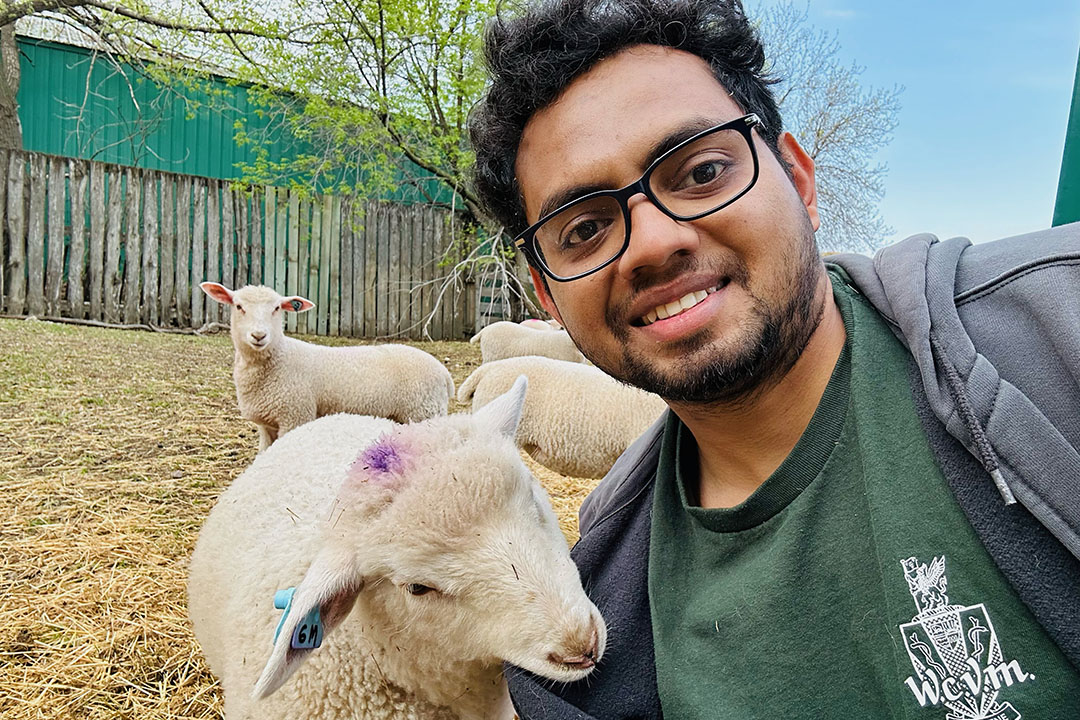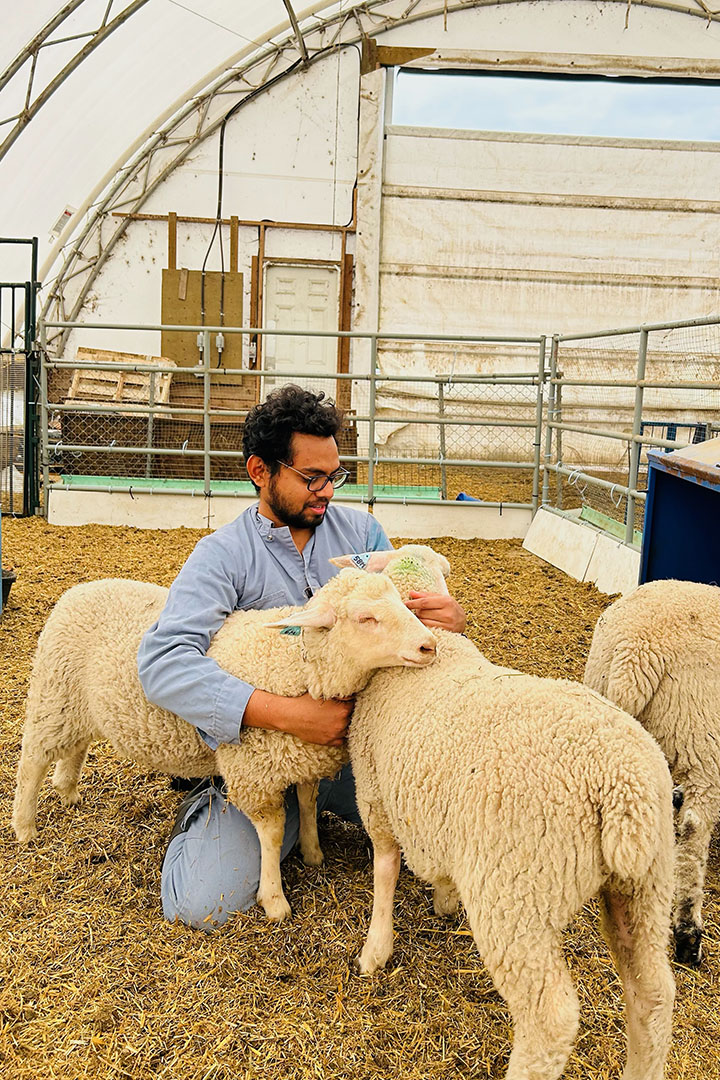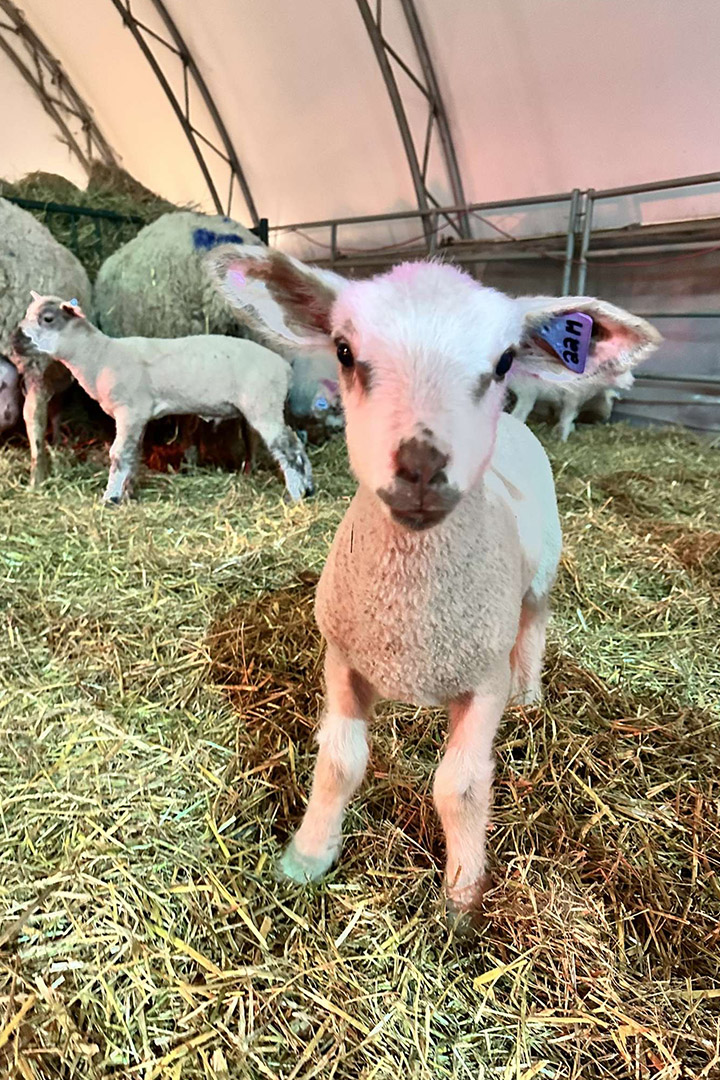
USask scientists evaluate timing for vaccinating sheep against deadly bacterial disease
In a new study targeting a deadly disease in lambs, scientists at the Western College of Veterinary Medicine (WCVM) are evaluating various vaccine protocols and their antibody concentrations to help sheep producers make better-informed decisions about disease prevention.
By Aidan Hamilton
A sheep producer steps out early one morning to check on her flock: it’s spring and the barn is full of baas and bleats as lambs leap around their mothers.
Several lambs, however, are not so spry. Frantically checking, the producer finds that eight lambs have died overnight. She racks her brain, trying to think of anything abnormal the day before — but all the lambs had been doing well. She finds another lamb lying on its side. The young seven-week-old lamb is still breathing, but it’s tossing its head back and showing signs of seizures. After a quick call to the local vet, they conclude that the young flock has likely developed enterotoxemia, also known as pulpy kidney disease or overeating disease. This lamb — like the other young animals — is unlikely to make it.
***
For Canadian producers and many sheep farmers worldwide, this scenario is common. Enterotoxemia, a disease caused by the bacterium Clostridium perfringens type D, affects primarily young lambs. Found in soil, the bacteria are considered commensal (symbiotic) — often already living inside sheep without injuring the host.
But under certain conditions, C. perfringens can become extremely harmful. Enterotoxemia develops suddenly, and treatment is rarely successful. Most often, the disease progresses so fast that lambs are simply found dead — causing high mortality rates among young sheep.
“Clostridium perfringens is commensal, usually living in the [sheep’s] small intestine,” says Dr. Suren Muthukumara, a University of Saskatchewan (USask) master’s student. His supervisor is Dr. Fabienne Uehlinger, an associate professor at the Western College of Veterinary Medicine (WCVM).
“When favourable conditions in the intestine facilitate the pathogen's production of toxins, the toxin is directly absorbed into circulation and then directly attacks [the lamb’s] brain, heart and lung tissue, resulting in sudden death in the acute form or neurological signs in other forms,” says Muthukumara.
Clostridium perfringens enterotoxemia is effectively prevented by vaccination and nutritional management. However, current vaccine protocol recommendations for C. perfringens are vague or contrary to sheep producers’ management practices. That’s why Muthukumara is studying various vaccination protocols to help prevent enterotoxemia — with financial support from Saskatchewan’s Agriculture Development Fund.
Vaccines work by providing an animal’s immune system with a template of what a harmful organism might look like so it can build up an immune defence before it encounters the real thing. Vaccines can be an effective tool for sheep producers, and it’s an important pre-emptive strategy for dealing with enterotoxemia in sheep.
“Because of its nature of sudden onset and its [enterotoxemia’s] economical importance ... prevention is better than a cure,” says Muthukumara. “If it is going on as a herd problem ... it will affect the overall production of the farm. There are no options to cure once the animal gets the disease. That's why we are focusing on vaccination.”

One challenge is figuring out which animals to vaccinate. Like human babies, lambs’ immune systems have not yet been “primed” or exposed to pathogens. However, unlike newborn humans, lambs don’t receive antibodies from their mothers (ewes) while developing in the womb.
“During the pregnancy period, the antibodies cannot transfer from the mother to the fetus. [Sheep] have a synepitheliochorial placenta — it completely separates fetal circulation from maternal circulation,” says Muthukumara.
Antibodies are an essential component of an animal’s immune system and play a particularly important role in protecting a lamb from enterotoxemia. Without antibody transfer in the womb, a lamb relies on colostrum (its mother’s first milk produced after birth), which contains essential antibodies developed over the ewe’s lifetime. Once a lamb is older, its immunity can then be boosted by additional vaccination.
“If we do proper immunization of the pregnant ewes closer to lambing, the antibodies directly go through the colostrum to the lambs,” says Muthukumara.
A vital aspect of an effective vaccination plan is knowing when to give these vaccines to the ewes — the timing of vaccination needs to maximize antibody transfer and minimize ewe stress. It’s also important to know how well the ewes pass their developed antibodies into their colostrum and how well lambs are protected after drinking colostrum.
While some vaccines that are available in Canada give guidance on optimal vaccination timing, others give no guidance at all. As well, vaccination times often conflict with the range of time when sheep farmers are comfortable handling their ewes or with vaccine recommendations in Canada’s Code of Practice for the Care and Handling of Sheep.
“In Canada, farmers frequently question when they should vaccinate their sheep — especially pregnant ewes and their lambs — against enterotoxemia. We are testing protocols that farmers currently use .... If any or all protocols give good results with adequate antibodies, we can say to Canadian sheep producers, ‘Now you can use this or that protocol ...,’” says Muthukumara.
However, Uehlinger emphasizes that this study isn’t designed to assess subsequent levels of protection: “We can only say that ‘this or that or all protocols resulted in the same (or different) antibody concentrations’ which — based on previous studies — should be protective.”
***
The following spring, the same sheep producer steps out the door toward her barn. She’s carrying the next set of clostridial disease booster vaccines for this season’s lambs. With advice from her veterinarian about how to minimize enterotoxemia risks and armed with a newly validated vaccination protocol, this year’s lambing season has been going smoothly. The producer vaccinated her ewes before lambing, and she’s now giving the lambs their booster shots at the optimal time according to a verified protocol. Last year’s large outbreak is a distant memory — hopefully, something that the producer and her family never have to deal with again.
***
Aidan Hamilton of Regina, Sask., is a second-year veterinary student at the WCVM who worked as a summer research student in 2024. His story is part of a series of articles written by WCVM summer research students.
Together, we will undertake the research the world needs. We invite you to join by supporting critical research at USask.
